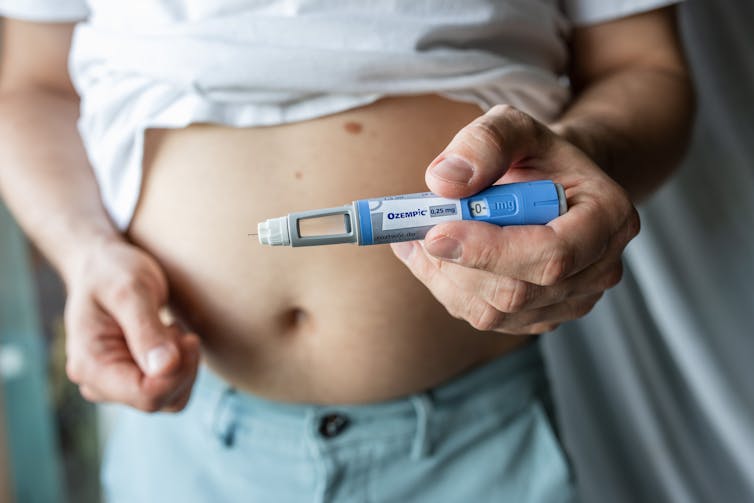
Sebastian Furness, The University of Queensland
Hundreds of thousands of people worldwide are taking drugs like Ozempic to lose weight. But what do we actually know about them? This month, The Conversation’s experts explore their rise, impact and potential consequences.
Every now and then, scientists develop treatments that end up being even more popular for another condition entirely. Think of Viagra, originally for high blood pressure, now used for erectile dysfunction. Or thalidomide, a dangerous morning sickness treatment that is now a valuable cancer treatment.
The blockbuster drug Ozempic was originally developed to treat type 2 diabetes, a condition that results in too much glucose, or sugar, in the blood. This is because the body can’t effectively use the insulin it produces.
In the 1980s, medications to treat type 2 diabetes would often lead to weight gain, which could worsen the condition. Patients would end up needing insulin replacement therapy.
But the class of drugs Ozempic belongs to would change this and generate A$21 billion of sales in 2023 alone for its maker.
The start of the journey
In the 19th century, French physiologist Claude Barnard sought to explain why large amounts of glucose (the main sugar in your blood) can be taken orally, whereas if glucose is given intravenously, small amounts overload the body’s systems.
In 1922 Frederick Banting and Charles Best discovered the hormone insulin, which controls glucose use. But this didn’t explain the difference between oral and intravenous glucose tolerance.
In 1932, Belgian Jean La Barre identified there was a hormone in the gastrointestinal tract responsible for stimulating insulin secretion. La Barre named this “incrétine” (incretin), a blending of ingestion and secretin, and suggested it may be a diabetes treatment.
In the 1960s, researchers showed the incretin effect was responsible for about two-thirds of people’s insulin response. New and sensitive ways to measure blood hormone levels then allowed researchers to show a hormone called GIP (glucose‐dependent insulinotropic polypeptide) was partly responsible for the incretin effect.
This meant there must be another hormone, whose discovery had to wait until the age of cloning in the 1980s. Cloning the GLP-1 (glucagon-like peptide 1) gene, biochemist Svetlana Mojsov demonstrated it stimulated pancreatic insulin secretion at 1/100th of the concentration needed for GIP. So GLP-1 was identified as the other incretin responsible for people’s insulin response.
The glucose-lowering effects of GIP and GLP-1 excited scientists, but they couldn’t be used as medicines because they metabolised too quickly in the body.
Enter a poisonous lizard
In the 1980s John Pisano, a biochemist with a penchant for venoms, and a young gastroenterologist Jean-Pierre Raufman were working with poisonous lizard venom from the Gila monster, a slow-moving reptile native to the south of the United States and north of Mexico. By the 1990s, Pisano, Raufman and colleague John Eng identified a hormone-like molecule they called exendin-4. This stimulated insulin secretion via action at the same receptor as GLP-1.
Excitingly, exendin-4 was not quickly metabolised by the body, and so might be useful as a diabetic therapeutic.
Eng was convinced this would work, but pharmaceutical companies didn’t want to give people a hormone mimic from a venomous lizard. Even the medical centre where Eng was working wouldn’t help fill the patent.

Eventually he and Raufman convinced a small start-up called Amylin Pharmaceuticals. Amylin quickly showed synthetic exendin-4 rapidly normalised blood glucose in type 2 diabetic mice. Exendin-4 then proved safe and effective in humans, leading to the 2005 US Food and Drug Administration (FDA) approval of exenatide, under the name Byetta.
It soon became evident that many taking Byetta were experiencing sustained weight-loss (around 5%, but with some experiencing much more), with the benefit of reversing their diabetic symptoms.
News of this weight-loss effect spread and within six months Byetta was being used off-label for weight-loss, foreshadowing the widespread use of Ozempic.
From a lizard toxin to Ozempic
Meanwhile, Danish pharmaceutical company Novo Nordisk had been developing a long-acting GLP-1-mimicking drug, as it had done for insulin in the past. Its research showed high levels of GLP-1 could correct diabetes in mice and they would lose weight.
During the 1990s, there was controversy over how GLP-1 led to weight loss, however it later became clear there were GLP-1 receptors in the brain that suppressed the desire to eat.
Novo Nordisk’s new GLP-1 drug had been designed to be long-acting. One consequence of this design was it was better at accessing brain GLP-1 receptors.
This new drug, liraglutide, approved as Victoza in 2010 in the United States, was better for weight-loss than Byetta (typically 10% weight-loss), but still needed daily injections.

Daily injections aren’t popular, and Novo Nordisk’s team had been working on an even longer acting drug, semaglutide, approved as Ozempic in 2017 as a once-weekly injection. It had improved brain GLP-1 receptor targeting, further enhancing weight loss.
Due to its safety profile and weight-loss efficacy (of around 15%), a higher dose of semaglutide gained FDA approval as Wegovy in 2021 as a stand-alone obesity treatment.
So how do these drugs actually work?
Your gastrointestinal tract contains specialised cells that measure the quantities and qualities of incoming food (as well as the absence of food) and communicates this with the rest of your body, including your brain.
You may remember Pavlov’s dogs, which were conditioned to expect a meal at the sound of a bell, kind of like what happens when you’re presented with a delicious plate of food. Not only does your brain make you salivate, it also starts the process of releasing digestive juices and even causes insulin levels to rise.
Ozempic and other GLP-1-mimicking drugs slow gastric emptying, which increases your sense of fullness.
Insulin secretion increases because there are nerves with GLP-1 receptors close to the wall of your gastrointestinal tract. This sends messages to the unconscious part of your brain that interpret these and send messages back (via nerves) to your gastrointestinal tract and pancreas to secrete insulin.
What about the new drug, Mounjaro?
Remember the other incretin hormone, GIP? GIP also suppresses appetite and can stimulate insulin secretion, but not as well as GLP-1.
Unlike GLP-1, GIP increases the secretion of another hormone, glucagon. Glucagon promotes energy use but also increases blood glucose during periods of fasting. Many felt the actions of glucagon needed to be blocked for effective anti-diabetic and weight-loss medications. But this doesn’t seem to be the case.
German physician and scientist Matthias Tschöp and American chemist Richard DiMarchi, who had met at Eli Lilly, were working on synthetic versions of glucagon to treat sudden drops in blood glucose when they unexpectedly found long-term dosing caused weight-loss in obese mice. Since GLP-1 and GIP are closely related, they thought it might be possible to target both receptors with a single drug.
In 2013, they showed a dual-acting drug was effective in obese mice. This led to the development of tirzepatide (Mounjaro and Zepbound, which is a slightly higher dose). Compared with GLP-1 drugs, it also stimulated metabolism, particularly fat use.
Clinical trials of Zepbound showed it to be more effective than Ozempic for weight-loss (typically 18% of body weight). Mounjaro was approved for type 2 diabetes in 2022 and Zepbound was approved for obesity in 2023.
GIP and GLP-1 are similar to glucagon so Tschöp and DiMarchi set out to develop a drug targeting all three. In 2014 they showed that a triple-targeting drug, which would become retatrutide, was superior in obese mice. Now in mid-stage clinical trials, Eli Lilly’s drug retatrutide (once-weekly injection) results in a weight loss of around 24% in obese adults.
Why can’t you take them in a pill?
These current drugs are big molecules (peptides) and for this reason must be injected as they’re not absorbed effectively in the gut.
In 2019, Novo Nordisk managed to reformulate semaglutide so some would make it through the stomach intact and enough got absorbed (about 1%) to be clinically effective. It repackaged this as Rybelsus.
But although enough of the drug gets into circulation to assist with type 2 diabetes, it requires 100 times the dose for weight-loss.

Both Pfizer and Eli Lilly have small-molecule drugs targeting the GLP-1 receptor. These are designed to be taken orally, are formulated for once-a-day, and would be less expensive than Ozempic or Mounjaro.
Pfizer’s drug, Danuglipron, has had mixed success in clinical trials. One formulation has been discontinued because of high clinical-trial drop-out rates (due to gastrointestinal side-effects such as nausea, vomiting, diarrhoea and pain). But both formulations do control type 2 diabetes and lead to about 10% weight-loss.
Eli Lilly’s trials of Orforglipron have shown promising weight-loss for obese participants of about 10%.
Plenty of weight-loss drugs have failed, too
Anti-obesity drugs with other targets – such as those sold under the brand names Qsymia, Contrave, Reductil and Accomplia – resulted in weight loss (typically less than 10%) but were accompanied by side effects such as increased heart rate, heart disease and psychological safety concerns such as anxiety and suicidal thoughts.
This resulted in market withdrawals and scared participants away from clinical trials.
Ozempic’s safety profile and effectiveness has reversed this, though there are a number of potential side effects (mainly gastric upsets) and people who stop taking Ozempic typically have big weight rebounds. Clinical trial recruitment is becoming easier and many pharmaceutical companies are playing catch up.
Read the other articles in The Conversation’s Ozempic series here.![]()
Sebastian Furness, ARC Future Fellow, School of Biomedical Sciences, The University of Queensland
This article is republished from The Conversation under a Creative Commons license. Read the original article.



